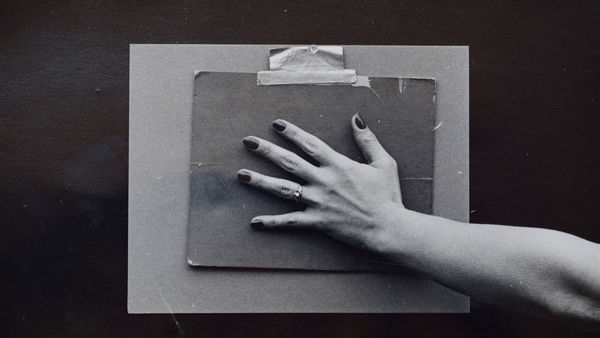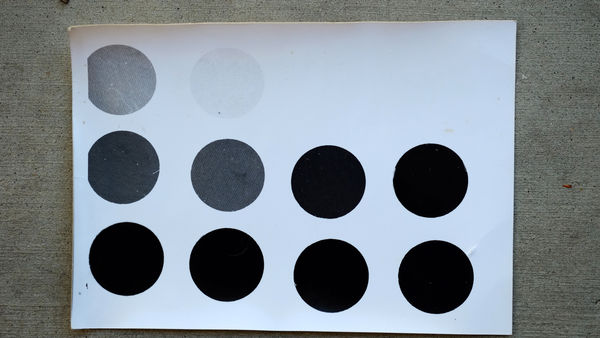Need Help with Exposure on an ALL manual camera!!!
Apr 16, 2013 10:28:34 #
doogie wrote:
Hi All. Photography Student here. br br My Camer... (show quote)
There are a lot of good answers here that should guide you to the controls in manual exposure. After that it is just possible that for some reason your meter is giving a higher exposure than required. Obviously, to compensate for this you can expose at one stop (or more) less than that indicated.
Apr 16, 2013 10:37:33 #
romanticf16
Loc: Commerce Twp, MI
Either your meter is off or something is wrong with how the film is being processed. Who is processing the film.Is it fresh developer? Mixed with distilled water? at 68degreesf? agitated in a tank per instructions? not holding the tank in your hands between agitation cycles,which will raise its temperature?
What type of road are you pointing the camera at-sand, blacktop or concrete? Try pointing the camera at the palm of your hand to get a average 18% meter reading for your exposure. This is an old photographer's trick. If the buildings are in shadow you'll need to open the lens up a stop or two. your instructor should be helping you solve these problems. At least to determine if the camera's meter is working properly.
What type of road are you pointing the camera at-sand, blacktop or concrete? Try pointing the camera at the palm of your hand to get a average 18% meter reading for your exposure. This is an old photographer's trick. If the buildings are in shadow you'll need to open the lens up a stop or two. your instructor should be helping you solve these problems. At least to determine if the camera's meter is working properly.
Apr 16, 2013 10:46:57 #
Zone system tests circa early 80's.
PS. Looks like two of the dots are out of order.
PS. Looks like two of the dots are out of order.
Hand on gray card on homemade target

Each circle = 1 f/stop change of exposure

Apr 16, 2013 10:57:09 #
doogie wrote:
Hi All. Photography Student here. br br My Camer... (show quote)
Where did you get your S-16 rule from? It idicates to me why your pictures could be over exposed.
On a sunny day with ISO 400 film / setting and aperture at f/16, shutter speed should be set to 1/400 or 1/500. So you are exposing for 200ASA and will be 1 stop over exposed.
For a very simple rule of thumb - on a sunny day, set the aperture to f16 and the shutter speed the same as the ISO number.
For a tutorial about Aperture, shutter speed and ISA checkout;
http://digital-photography-school.com/moving-toward-manual-settings-understanding-basic-daylight-exposure-and-equivelant-exposure
Apr 16, 2013 11:18:35 #
photocat
Loc: Atlanta, Ga
THe op indicates the negatives are thin, which is not over exposed, and in fact if the shutter speed is at 250 and fstop at 16 they are seriously underexposed.
It is not usually to halve the ISO to be sure to capture shadow detail, but the negatives should not be too thin.
Again, check with your insturctor. Have them look at the negatives with you.
Learning to read negatives takes time and practice.
It is not usually to halve the ISO to be sure to capture shadow detail, but the negatives should not be too thin.
Again, check with your insturctor. Have them look at the negatives with you.
Learning to read negatives takes time and practice.
Apr 16, 2013 11:26:05 #
snohomish98
Loc: Coastal Carolina
Tryto"bracket the photos", 3 frames of the same subject, one normal and one over expouser and one underexpouser.
one of the photos should be nice
one of the photos should be nice
Apr 16, 2013 11:54:21 #
Mogul wrote:
Also, keep another part of the log for meter readings, environmental conditions and exposure data.
Well, duh! :wink:
I'm just now reentering film world and having to relearn the basics. I shot a test roll and recorded the vitals for each frame - which lens, filters, shutter speed, aperture, light conditions, reflected or incident light reading. Bracketed most shots, e.g., f4 at 1/125, 1/250, 1/500th. But I didn't think about writing down the meter readings. Now I have a page full of notes that really tell me nothing! :cry:
BTW, lot of good info here. Thanks everyone.
Apr 16, 2013 14:26:24 #
Your in-camera reflective meter will deceive you, or more specifically, the lights and darks in a scene will fool your meter, but you can also outsmart all of that. An inexpensive handheld meter might be useful (ebay/craigslist). Short of that, you can emulate an incidence reading by using a gray card and your in-camera meter. Make sure you have your camera set for the right asa of the film you're using, hold the gray card up in front of your subject so it catches the same light that is falling on your subject, preferably with the light behind you, aim the camera at the gray card filling the frame, get a meter reading, set the shutter speed and aperture from that reading and you should get good exposure as long as the light remains steady and you are shooting still in the same direction. If you want to shoot a person who is backlit, move up close to fill the frame with the face of that person, get a meter reading, set the readings, move back, frame, and shoot. Lens hoods are always good to mitigate extraneous light from entering your lens diluting the readings, especially if the light is coming from a side angle.
"Sunny 16" is good in the absence of using one of the above procedures but lighting conditions are on a sliding scale and cannot always be judged with complete accuracy. As a substitute for a gray card, you can use the palm of your hand which is lighter than a gray card - "hold up your hand, meter, which way is your thumb pointing (up) so open up one stop," or for other approximations you can use medium tones such as grass, sand, light pavement, etc., anything that approximates 12% to 18% gray.
"Sunny 16" is good in the absence of using one of the above procedures but lighting conditions are on a sliding scale and cannot always be judged with complete accuracy. As a substitute for a gray card, you can use the palm of your hand which is lighter than a gray card - "hold up your hand, meter, which way is your thumb pointing (up) so open up one stop," or for other approximations you can use medium tones such as grass, sand, light pavement, etc., anything that approximates 12% to 18% gray.
Apr 16, 2013 19:19:28 #
Hello doogie
Here is a site that might help you in your development of film. See site listed below.
http://www.silverlight.co.uk/tutorials/basicpf/filmprobs.html
Here is a site that might help you in your development of film. See site listed below.
http://www.silverlight.co.uk/tutorials/basicpf/filmprobs.html
doogie wrote:
Hi All. Photography Student here. br br My Camer... (show quote)
Apr 16, 2013 20:32:09 #
I read this trick MANY,MANY years ago in a Photo Mag about in Camera Metering. Was reported to work very well and accurately. Take a Styrofoam Cup that fits snugly over your lens. Then, when metering the INCIDENT LIGHT, from the subject, point the lens towards where you would be shooting from, or the brightest area of the sky illuminating your subject. I think you'd have to play around with aiming 180 degrees behind you as that light is the directly reflected light from your subject. This has the same effect as the "ping pong ball" covers that many off-camera incident meters used to meter the LIGHT SOURCE. see this link: http://fotosharp.com/unusualphototipstricks.html
As Styrofoam cups have different thicknesses, you'd have to play with it, but it would be fun to figure it out and see what happens. Here's also an article for using a Styrofoam Cup to help you set the correct WHITE BALANCE. http://inancy.wordpress.com/diy-incident-light-meter-and-custom-white-balance/
As Styrofoam cups have different thicknesses, you'd have to play with it, but it would be fun to figure it out and see what happens. Here's also an article for using a Styrofoam Cup to help you set the correct WHITE BALANCE. http://inancy.wordpress.com/diy-incident-light-meter-and-custom-white-balance/
Apr 16, 2013 20:47:59 #
I am going to jump in again. Since all your negatives were the same I don't think your technic is bad I just think you need to open up your f stop 2 stops or go down on your speed two speeds on every shot and you will come out fine. - Dave
Apr 16, 2013 20:59:58 #
phil7782 wrote:
Take a Styrofoam Cup that fits snugly over your lens.
That can't work Phil, 'cause it's free. :-D Oh, hell, I'll try it anyway. Thanks. :thumbup:
Apr 16, 2013 21:55:25 #
Two words: "Zone System".
You need a apot meter. Meter the highlights and the shadows. How many stops difference is there between the highlights which you want to still retain some texture, (Zone VIII) and the shadows in which you want to retain some texture, (Zone II)? If it is a normal exposure, it should be 6 stops. If it is more than that you will need to pull the exposure on development. If it is less than that you may want to push the exposure on development. It really depends upon how much contrast you want to create in the scene. If I am getting 4 stops difference in a foggy morning shot, I probably don't want to push the development to increase the contrast. (The beauty in a fog shot is the low contrast.)
If you are shooting 35 mm, the push and pull processing is not possible unless you have multiple bodies which are marked as +1, 0, -1, which you alternate between based on how you want to develop the film (to increase contrast, retain contrast, or decrease contrast.)
You need a apot meter. Meter the highlights and the shadows. How many stops difference is there between the highlights which you want to still retain some texture, (Zone VIII) and the shadows in which you want to retain some texture, (Zone II)? If it is a normal exposure, it should be 6 stops. If it is more than that you will need to pull the exposure on development. If it is less than that you may want to push the exposure on development. It really depends upon how much contrast you want to create in the scene. If I am getting 4 stops difference in a foggy morning shot, I probably don't want to push the development to increase the contrast. (The beauty in a fog shot is the low contrast.)
If you are shooting 35 mm, the push and pull processing is not possible unless you have multiple bodies which are marked as +1, 0, -1, which you alternate between based on how you want to develop the film (to increase contrast, retain contrast, or decrease contrast.)
Apr 16, 2013 23:22:25 #
doogie wrote:
Hi All. Photography Student here.
My Camera is a Pentax K1000. The only meter I have available (That makes sense) is the one inside the camera. The professor keeps saying "Your light meter will lie to you". Developed my first three rolls of film and ALL of them are thin. We are working with B/W film.
Doogie
My Camera is a Pentax K1000. The only meter I have available (That makes sense) is the one inside the camera. The professor keeps saying "Your light meter will lie to you". Developed my first three rolls of film and ALL of them are thin. We are working with B/W film.
Doogie
Others here have tried to give you advice, so I will not cover that ground again. But I seriously question the integrity of your instructor in the way he has treated you. If you have questions it is the DUTY of the instructor to help you overcome your difficulties. From what you wrote, it seems the instructor was giving you the "brush-off." If I treated my students in such a rude, cavalier manner, I would lose my job. I you are paying good money for the course, you have a right to expect good instruction.
If you have misconceptions, it is up to the instructor to make a good-faith effort to set you straight.
"Thin" negatives can result from underexposure or from under-development. Under-development may result from not enough development time, or from exhausted or contaminated chemicals. Without examining your negatives, it is impossible to give a reasonable answer.
In any event, I would have a real "heart-to-heart" with that instructor.
Apr 17, 2013 00:48:34 #
JudyTee23 wrote:
Others here have tried to give you advice, so I wi... (show quote)
Judy, obviously you have both the technical expertise and experience as an educator to give Doogie excellent advice. If, I may, I would like to call on your experience - and your acquired instincts about our educational system - to tell me if you truly believe that an (assumed tenured and assumed college level) "professor" (that's what Doogie called him/her) will invest the time and effort to solve the problem. I have met several of my children's community college and advanced college instructors. They impress me, in general, as people who are more driven by their desire to attain status in politically motivated system than to impart wisdom to their students. This discovery has been disappointing, as them seem to be differently than were my college instructors. I know that the majority of teachers today, particularly those in primary and secondary education, are deeply driven and highly motivated to provide a positive and lasting learning experience for their students. I wonder if the same is true of those teaching in our higher levels of education, or will Doogie not only be disappointed in the answers received (if any), but suffer a loss of status in the class for appearing to challenge the status quo?
If you want to reply, then register here. Registration is free and your account is created instantly, so you can post right away.






